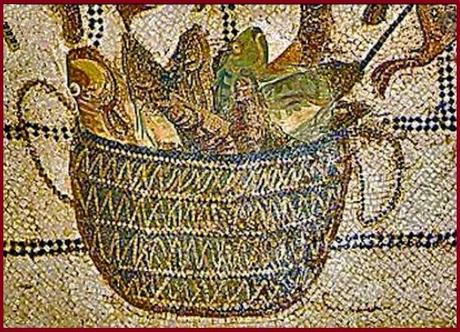Imagine you are leaning back in your chair after a delicious meal at a friend’s house. You congratulate your host on the sauce that had added such flavor to the main course. And the host replying enthusiastically, and in some detail, about how the sauce was made.
Take the fresh spilled blood of the still-beating heart of a live mackerel, mix with the creature’s entrails, salt and leave to rot in the sun, until, weeks later when the solids were putrefied nicely then a sort of goo emerges which is strained, bottled and ready to use.
If you haven’t had to make a quick trip to the bathroom then you will find out that that you have just had Garum, a sauce so essential to ancient Rome that it was consumed by all sections of its population and its Empire. The cheapest form of it was used to flavor the daily porridge of the poor and the most expensive could cost a small fortune. And it is making a comeback in some places and in others it has never gone away.
Remains of garum factories have been excavated from Spain to Portugal to northern Africa. Some of these factories appear to have employed upwards of 50 people. The production of garum created such unpleasant smells that factories were generally relegated to the outskirts of cities. After it was manufactured a huge network of trade routes grew up to move the stuff from fishery to plate. It was enjoyed as far away as Hadrian’s Wall.

Not every Roman was so keen. Seneca, the Roman philosopher writing in about the year 60 CE, cautions against it: ‘Do you not realize that garum sociorum, that expensive bloody mass of decayed fish, consumes the stomach with its salted putrefaction?’ Quite.
I had a memory of garlic and Finland when I read this from the Roman poet Martial who wrote... ‘dating someone who'd recently eaten garum was a frightening proposition’.
However, it did have other uses. Garum was also employed as a medicine. It was thought to be one of the best cures for many ailments, including dog bites, dysentery, and ulcers, and to ease chronic diarrhoea and treat constipation. Garum was even used as an ingredient in cosmetics and for removal of unwanted hair and freckles.
But just as you may be thinking ‘ok, not all bad’ comes the news that the biological anthropologist Piers Mitchell suggests that Garum may have helped spread fish tapeworms across Europe.
You’d never believe where I got the idea for writing about Garum. I was going to write this article on Lea & Perrins Worcestershire Sauce as I know nothing about sauces but I had been to Great Malvern last year and came across their original shop before they moved to Worcester. And guess what is considered the great, great, great... grandparent of Worcester Sauce.
There are many, many times when I think how happy I am being vegetarian.
Notes for this were taken from: National Geographic, NPR, The Guardian, romanobritain, foodreference.
And if you still want to learn more or make some then try this website called Pass the Garum.

It was on this table five years ago
we’d fought for the last of the broccoli
chasing it round a bowl you’d bought
from that shop on a farm in the Lakes.
It wasn’t a special occasion,
I think that you’d been on lates
and I’ve no idea how it started
but remember the look in your eyes
saying I’d definitely cheated
and I’m saying the bloody things mine,
the crisp green floret
dripping with butter and laughter.
In the restaurant we talked,
dabbling with bread rolls and wine
and the best time to leave
for your ferry in the morning
and how you’d be back in April
for a break and your nephew’s wedding
then, smiling, the waiter brought dinner
and you told me how you’d met
about laughter, kindness, friendship
and politely offered the last of the broccoli,
the crisp green floret
dripping with butter and sauces.
Terry Quinn
Email ThisBlogThis!Share to TwitterShare to Facebook
